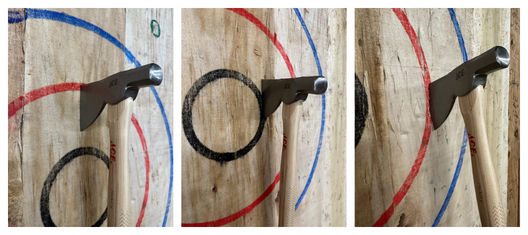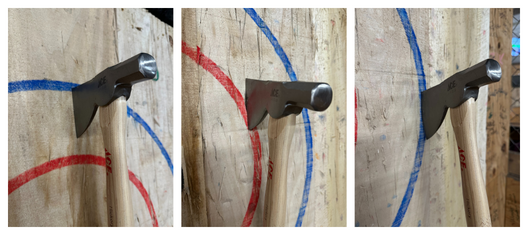About Urban Axes
Axe Throwing
Experiences
Locations

Urban Rules
Unifying the Rules - Urban Rules
Urban Axes new scoring system hopes to bring our throwers together again.

published 5/23/23
Unifying the Rules - Urban Rules
Urban Axes new scoring system hopes to bring our throwers together again.
Urban Axes is excited to announce we’re developing a new scoring format for use in select events at our upcoming major tournaments. The unified ruleset, or Urban Rules, is intended to address some of the feedback we’ve heard from our league members (and the axe throwing community at large), about the divisions caused by Premier and Standard rulesets. Urban Rules is not intended to replace these rulesets. We will continue to run Premier and Standard rules tournaments, and our leagues will continue to follow these rulesets as well. We've designed Urban Rules to accommodate both Premier and Standard axe throwers, and these rules provide us another way to bring throwers of all ability levels together at our tournaments while remaining challenging, strategic, and fun!
Our Goals
We want to bring throwers back together.
Urban Rules is designed to restore a sense of camaraderie and unity between tournament competitors by allowing everyone to throw together under the same ruleset.
We want to reward throwers for their accuracy without punishing them for errant throws.
Throwing an accurate Clutch but missing the Premier box by an ⅛” or “bleeding” a Premier bullseye by a millimeter can be discouraging. Urban Rules gives full credit to Premier throws but rewards close throws with additional points that reflect the relative accuracy of the throw.
We want to encourage fun & competition among throwers of varying experience levels.
A loss of 2 points for every “bleeding” bullseye and no points for "touch" Clutches creates a wide scoring gap between experienced and emerging throwers. Urban Rules diminishes the gap between majority bulleyes and Premier bulleyes and also restores "touch" Clutches. Our goal is creating closer scores that keep matches exciting and competitive for all throwers.
We want to reduce the "all or nothing" aspect of Premier Big Axe tie breakers.
Premier Big Axe remains very challenging, and throwers often receive the same score for a “bleeding” Big Axe bullseye as a throw that was entirely in the 3-point ring. Similarly, a Premier Big Axe Clutch throw that touched the Clutch scores the same as a throw that missed the Clutch entirely. Urban Rules rewards consistent Big Axe accuracy with the advantage it deserves.
We want to improve match speed by allowing all throws to be scored without measurement.
One improvement Premier rules introduced is no need for a measurement to determine where the majority of a blade rests in the target. Urban Rules scoring does not require any measurement either. Most throws can be scored at a glance or a referee can quickly examine close Premier bullseyes or Clutches. Scoring without any measurement interruptions improves the flow of matches and helps tournaments run smoothly. No more calipers!
Urban Rules
1 - Urban Rules is an additional ruleset that follows all current IATF rules and regulations other than the changes and clarifications specified in this document.
2 - Tournament rounds and matches retain their current playoff format, i.e. 5 throw rounds, best 3 out 5 matches, and best 5 out of 7 for finals matches.
3 - Competitors must select 1 hatchet and 1 Big Axe to throw for the duration of a match.
3.1 - Throwers may not throw one hatchet at the bullseye and another hatchet at the Clutch. The same applies to Big Axe throws. Throwers should select one hatchet and one Big Axe that suits their throw and will give them the best opportunity to score Premier bullseyes and Clutches.
3.2 - If an axe is damaged during a match, the thrower may choose a replacement.
3.2.1 - An axe is considered “damaged” when the handle or blade has cracked or broken and is determined by a referee to be either: 1) unsafe for the thrower to use, or 2) further use would jeopardize the thrower’s ability to preserve the axe.
3.2.2 - A damaged axe replacement may occur at any time during the match.
3.2.3 - The replacement axe will then be thrown for the remainder of the match.
4 - Players must score a Premier bullseye before “unlocking” Clutch during a Big Axe tiebreaker.
4.1 - A previous “majority bull” now scores a 4 or 3, so these throws will not be considered a bullseye for the purpose of unlocking the Clutch.
4.2 - Once each player has scored a Premier bullseye, Clutch may be called by one or both players, and both touch Clutch and Premier Clutch scoring values are then available.
4.3 - Players are allowed 3 missed attempts in a row at Big Axe Clutch before they must “bull-in” again. Each time the clutch is hit by both players, this count resets.
5 - The scoring portion of a blade is measured at the surface of the target as normal.
Scoring
6.1 - A Premier bullseye, as defined by the IATF, scores 5 points.
6.1.2 - The blade may cross the inner edge of the black painted line but not the outer edge. The axe may stick fully within the paint of the black line and score 5 points.

6.2 - A blade that crosses the inner and outer edges of the black painted line scores 4 points.
6.2.1 - The majority of the blade is not considered in this ruling. If both edges of the black line are crossed, the axe scores 4 points.

6.3 - A blade that lies fully within the 3-point scoring ring scores 3 points.
6.3.1 - A blade that crosses from the 3-point ring into the outer edge of the black line but does not cross the inner edge of the black line scores 3 points.
6.3.2 - The blade may cross the inner edge of the red painted line but not the outer edge. The axe may stick fully within the paint of the red line and score 3 points.

6.4 - A blade that crosses the inner and outer edges of the red painted line scores 2 points.
6.4.1 - The majority of the blade is not considered in this ruling. If both edges of the red line are crossed, the axe scores 2 points.

6.5 - A blade that lies fully within the 1-point scoring ring scores 1 point.
6.5.1 - A blade that crosses from the 1-point ring into the outer edge of the red line but does not cross the inner edge of the red line scores 1 point.
6.5.2 - The blade may cross the inner edge of the blue painted line but not the outer edge. The axe may stick fully within the paint of the blue line and score 1 point.

6.6 - A blade that crosses inner and outer edges of the blue painted line scores 0 points.
6.6.1 - The majority of the blade is not considered in this ruling. If both edges of the blue line are crossed, the axe scores 0 points.

6.7 - A touch Clutch scores 5 points.
6.7.1 – An axe that sticks fully within the 2” Clutch, but not fully within the white painted Premier box, scores as a touch Clutch. This would be considered a “no bleed” touch Clutch, and scores 5 points.

6.8 - A Premier Clutch scores 8 points.
6.8.1 - An axe that sticks fully inside the white painted Premier box, with no blade breaking any edge of the box, also scores as a Premier Clutch. This would be considered a “no bleed” Premier Clutch and socres 8 points.

Our Logic
Why is a touch Clutch worth 5 points?
- The challenge level of a touch Clutch is similar to the challenge level of a Premier bullseye, so we have decided to award it the same score of 5 points:
- With a 4” blade, a Premier bullseye has a 27.86 sq inch hit zone and a touch Clutch has a 19.14 sq inch hit zone.

- With a 4” blade, a Premier bullseye has a 7” vertical scoring range. A 4” blade can only travel 1.5” high or low of center before the axe will bleed outside the black line.
- With a 4” blade, a touch Clutch has an almost 10” vertical scoring range. A 4“ blade can travel just under 5” high or low of center before it misses a touch Clutch.
- A 3” blade awards an additional 1” to the Premier bullseye vertical scoring range, but the vertical scoring range of a touch Clutch decreases by 2” with a 3”blade.
- Premier bullseye allows more horizontal variance than touch Clutch, but touch Clutch allows more vertical variance, and we feel this gives both throws a comparable difficulty.
Why is a Premier Clutch worth 8 points?
- A Premier Clutch scores 8 points due to its difficulty when compared to a touch Clutch.
- A Premier Clutch is much harder to hit than 5-point touch Clutch and deserves more than a 2-point advantage. We settled on 3 because it only slightly changes the traditional scoring and creates multiple round outcomes we believe throwers will find exciting.
What sort of sort of competitive scenarios will this 3 point difference create?
Scenario 1: A thrower trailing by 3 points on fifth axe may now tie the round with a Premier clutch should their opponent choose to stay down and throw a Premier bullseye.
Scenario 2: A thrower leading by 3 or more points on fifth axe is no longer disincentivized to attempt Clutch.
- If the leading thrower scores a touch Clutch, their opponent will need a Premier Clutch to tie the round.
- If the leading thrower hits a Premier Clutch, they take the round out of reach.
Scenario 3: A thrower leading by 1 or 2 points on fifth axe may still choose to attempt Clutch.
- If the leading thrower hits a Premier bullseye or touch Clutch, they receive 5 points and would lead by 6 or 7 points, leaving them vulnerable to a Premier Clutch from their opponent.
- Attempting Premier Clutch allows the leading thrower the chance to take the round out of reach, with the assurance that a touch Clutch will guarantee their opponent needs a Premier Clutch to win.
How will Urban Rules affect Big Axe tiebreakers?
- A player could now choose to attempt a Clutch even if their opponent opts to throw bullseye. A touch Clutch would tie a Premier bullseye, with the possibility that a Premier Clutch would win the round.
- If both players call Clutch, a player that touches Clutch will win the round over a player that misses the Clutch entirely.
- If one player touches the Clutch and the other hits a Premier Clutch, the second player is rewarded for the accomplishment by winning the round.
- More granularity in scoring options also creates the potential for more big axe tiebreakers in alternate tournament formats such as Swiss style tournaments.
Conclusion
We are very excited by the possibilities that Urban Rules presents, and we plan to host trial events at select Urban Axes locations to improve and refine the ruleset. We want Urban Rules to reflect the ideas and desires of the axe throwing community. We welcome suggestions and feedback and will share what we learn as we run our trial events. We will monitor discussions in our Facebook community and, as always, feel free to contact Nathan Ford and Matt Paton directly at nathan@urbanaxes.com and matt@urbanaxes.com.
We will be hosting Standard and Premier events at our upcoming tournaments, and some Urban Rules events will be featured at these tournaments as well. So, if you’re as excited as we are to try this new ruleset, keep an eye on our tournament announcements and sign-up to come throw with us!